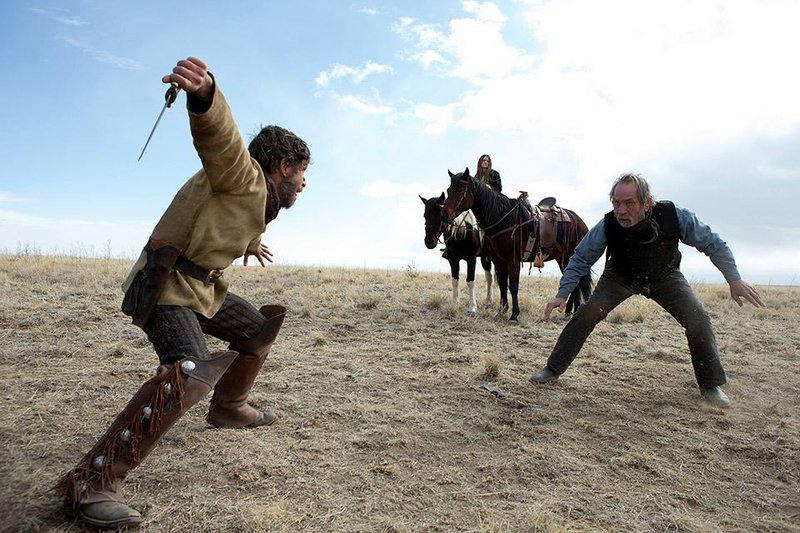The Homesman is not a movie that fits comfortably into any established rubric; to call it a Western is to invite the disgust of its director/star Tommy Lee Jones, who (though he may well be the unhappiest thriving human being on the planet) actually has a point. No true artist condones the genrefication of his work.
But The Homesman is set mainly in the high and featureless plains of Nebraska in the mid-19th century. There are horses and men in hats and it takes for its heroine a stubborn frontier woman who is strong, hard and -- in the words of a refusenik suitor -- "plain as an old tin pail."
The Homesman
90 Cast: Hilary Swank, Tommy Lee Jones, John Lithgow, Grace Gummer, Miranda Otto, Sonja Richter, Tim Blake Nelson, James Spader, Evan Jones, Meryl Streep
Director: Tommy Lee Jones
Rating: R, for violence, sexual content, some disturbing behavior and nudity
Running time: 122 minutes
Still, Mary Bee Cuddy (Hilary Swank) has carved out a little empire in this unforgiving land. She has two claims, a couple of mules and money enough in the bank to afford peaches from a can. For the time being, she practices her piano on a cloth runner upon which the keys have been embroidered, but she has ordered an instrument from back East.
She is lonely, but while it would make practical sense for one of the unattached men to marry her, they all find her indomitable. "Too bossy" is how they phrase it, but the truth is the depressive Cuddy possesses the steel necessary to live in such a harsh, cold place. The winter drives some mad.
Three of the settlers' wives, for instance, have gone over the edge. Reverend Dowd (John Lithgow) arranges for their husbands to draw lots to decide who will escort the women back across the Missouri River. But the men balk, and Cuddy -- disgusted with their cowardice and perhaps needing an adventure of her own -- volunteers.
But before she lights out with her charges, she encounters petty outlaw George Briggs (Jones) and saves him from hanging on the condition that he accompany her on the journey.
Briggs is one of those cantankerous codgers who populates a certain kind of period drama set in the 19th-century-American West. When we first meet him he's in his long johns and that ridiculous sort of blackface that we are to believe results when someone is in close proximity to a black powder explosion. (Maybe that actually happens. Get Mythbusters on the case.)
But if Briggs first appears cartoonish -- a cross between Lee Marvin's Kid Shelleen and Yosemite Sam -- once he and Cuddy start out with their genuinely mad charges (Grace Gummer, Sonja Richter and Miranda Otto), the film deepens into a bleak and humane story about doing what is sadly necessary.
Both actors are working at a high level here, imbuing Cuddy and Briggs with deep reservoirs of compassion to go along with their practical skills and gruff exteriors. As they roll east, the group somehow forms a jury-rigged family facing the traditional hazards of Indians and renegades as well as more nuanced psychological terrors.
This is Jones' second film as director, and it's a big step up from the modestly conceived, stark and violent The Three Burials of Melquiades Estrada. In that film, Jones seems content to pay homage to Sam Peckinpah. The Homesman is more like John Ford's best film, The Searchers. It's more subversive than revisionist, with a shocking moment in the middle of the third act that feels earned and bitterly true. If it didn't go on for perhaps an extra 20 minutes past what seemed to me to be a logical ending point into a diffusive coda, it might have been a genuinely great movie.
It's not that the ending ruins everything, it's just that for 90 minutes or so, The Homesman is a completely hypnotic, powerful experience. The opening sequence, which begins with Cuddy commanding a mule team before displaying a clumsier femininity, is a very funny, heartbreaking parody of attempted seduction.
Much credit is due cinematographer Rodrigo Prieto, who captures a wide-skied prairie reminiscent of Andrew Wyeth's paintings, and Benton native Merideth Boswell's at times unnerving production design, which betrays the yearning and the provisional nature of frontier civilization. As our party moves east, the sod huts and treeless prairies give way to a kind of jarring artificiality -- the marked-out streets of a planned community turn out to be crueler than the cold, unbroken plains.
MovieStyle on 12/12/2014

